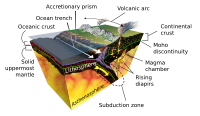
Photo from wikipedia
Subduction and exhumation dynamics can be investigated through analysis of metamorphic and deformational evolution of associated high-grade rocks. The Erzgebirge anticline, which forms at the boundary between the Saxothuringian and… Click to show full abstract
Subduction and exhumation dynamics can be investigated through analysis of metamorphic and deformational evolution of associated high-grade rocks. The Erzgebirge anticline, which forms at the boundary between the Saxothuringian and Tepla-Barrandian domains of the Bohemian Massif, provides a useful study area for these processes owing to the occurrence of numerous meta-basites preserving eclogite facies assemblages, and coesite and diamond bearing quartzofeldspathic lithologies indicating subduction to deep mantle depths. The prograde and retrograde evolution of meta-basite from the Czech portion of the Erzgebirge anticline has been constrained through a combination of thermodynamic modelling and conventional thermobarometry. Garnet growth zoning indicates that the rocks underwent burial and heating to peak conditions of 2.6 GPa and at least 615 °C. Initial exhumation occurred with concurrent cooling and decompression resulting in the growth of amphibole and zoisite poikiloblasts overgrowing and including the eclogite facies assemblage. The development of clinopyroxene–plagioclase–amphibole symplectites after omphacite and Al-rich rims on matrix amphibole indicate later heating at the base of the lower crust. Omphacite microstructures, in particular grain size analysis and lattice-preferred orientations, indicate that the prograde evolution was characterized by a constrictional strain geometry transitioning into plane strain and oblate fabrics during exhumation. The initial constrictional strain pattern is interpreted as being controlled by competing slab pull and crustal buoyancy forces leading to necking of the subducting slab. The transition to plane strain and flattening geometries represents transfer of material from the subducting lithosphere into a subduction channel, break-off of the dense slab and rebound of the buoyant crustal material.
Journal Title: Journal of Metamorphic Geology
Year Published: 2017
Link to full text (if available)
Share on Social Media: Sign Up to like & get
recommendations!